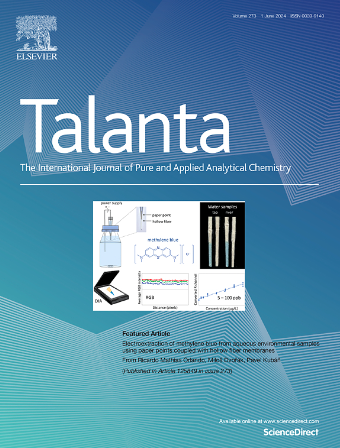Development of universal isotachophoresis – capillary zone electrophoresis method for trace determination of bromide in complex ionogenic samples
IF 5.6
1区 化学
Q1 CHEMISTRY, ANALYTICAL
引用次数: 0
Abstract
Trace determination of bromide in water samples and high-purity chemicals was accomplished by capillary zone electrophoresis (CZE) with online isotachophoresis (ITP) sample pretreatment and photometric detection at 200 nm. The adverse effect of bromide on human health necessitates its monitoring in drinking water. Bromide is also a precursor of bromate, a carcinogenic by-product of water disinfection that can be formed in drinking water during ozonation (oxidation of bromide to bromate). ITP-CZE separations were performed at acidic pH (2.7) as this facilitates high selectivity of the separation system. Addition of the zwitterionic surfactant N-dodecyl-N,N-dimethyl-3-ammonio-1-propanesulfonate to the leading electrolyte enhanced the separation of bromide from anionic macrocomponents in drinking water. The first separation step, ITP, served as a very efficient sample clean-up. Linear response was observed in the presence and absence of matrix in the concentration range 1–50 μg/L. ITP-CZE separations were characterized by very good repeatability of migration times (up to 0.4 % RSD) as well as peak areas (up to 3.7 % RSD) of bromide. The achieved limit of detection for bromide was 0.3 μg/L in the presence of matrix. To assess the practical applicability of the developed test procedure, samples of mineral and drinking water, as well as highly pure chloride salts, were analyzed. Recoveries of bromide in the analyzed samples were in the range of 98–103 %. The developed ITP-CZE method can be used for highly selective determination of trace concentrations of bromide present in ionogenic samples.

开发用于痕量测定复杂离子源样品中溴化物的通用等位电泳-毛细管区带电泳方法
本文章由计算机程序翻译,如有差异,请以英文原文为准。
求助全文
约1分钟内获得全文
求助全文
来源期刊

Talanta
化学-分析化学
CiteScore
12.30
自引率
4.90%
发文量
861
审稿时长
29 days
期刊介绍:
Talanta provides a forum for the publication of original research papers, short communications, and critical reviews in all branches of pure and applied analytical chemistry. Papers are evaluated based on established guidelines, including the fundamental nature of the study, scientific novelty, substantial improvement or advantage over existing technology or methods, and demonstrated analytical applicability. Original research papers on fundamental studies, and on novel sensor and instrumentation developments, are encouraged. Novel or improved applications in areas such as clinical and biological chemistry, environmental analysis, geochemistry, materials science and engineering, and analytical platforms for omics development are welcome.
Analytical performance of methods should be determined, including interference and matrix effects, and methods should be validated by comparison with a standard method, or analysis of a certified reference material. Simple spiking recoveries may not be sufficient. The developed method should especially comprise information on selectivity, sensitivity, detection limits, accuracy, and reliability. However, applying official validation or robustness studies to a routine method or technique does not necessarily constitute novelty. Proper statistical treatment of the data should be provided. Relevant literature should be cited, including related publications by the authors, and authors should discuss how their proposed methodology compares with previously reported methods.
 求助内容:
求助内容: 应助结果提醒方式:
应助结果提醒方式:


